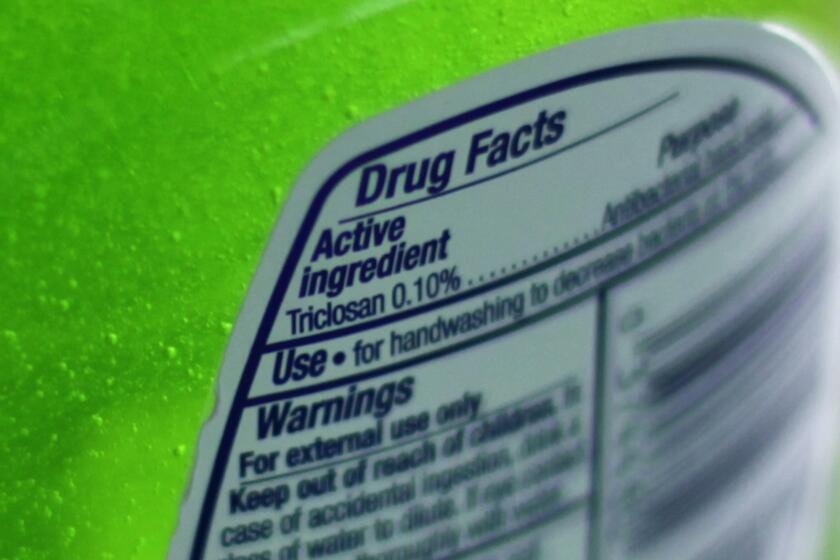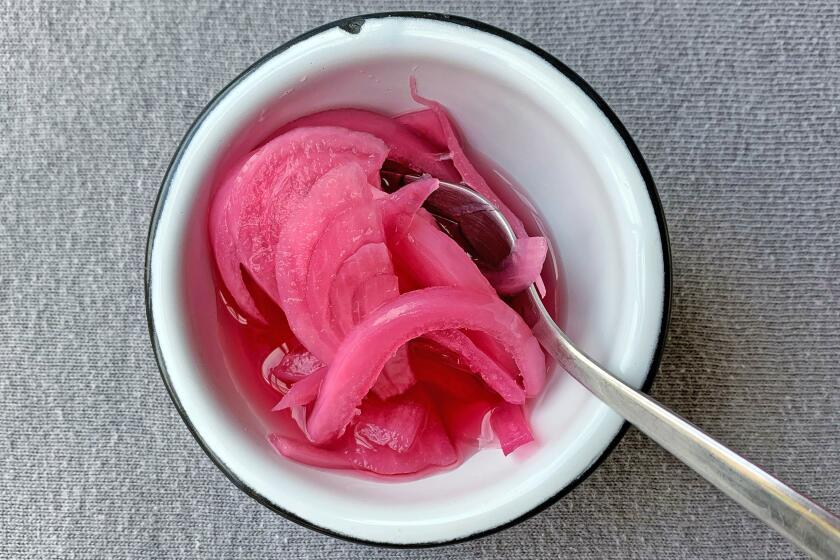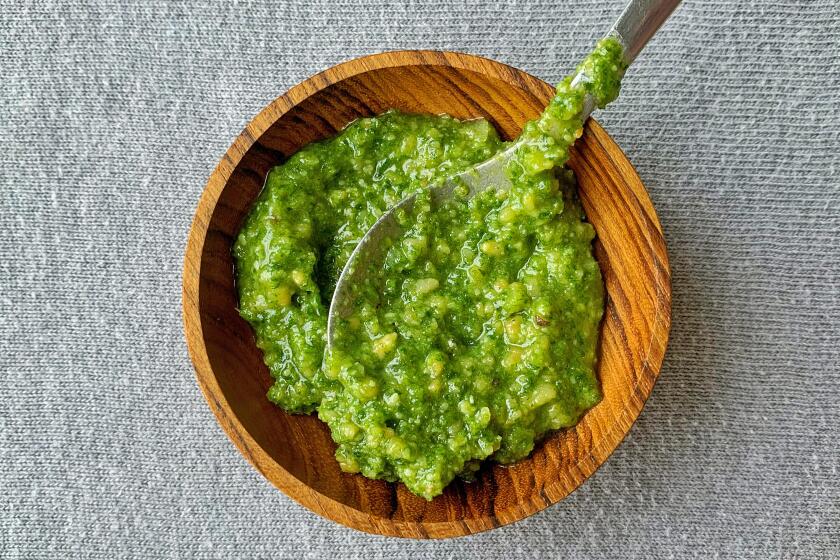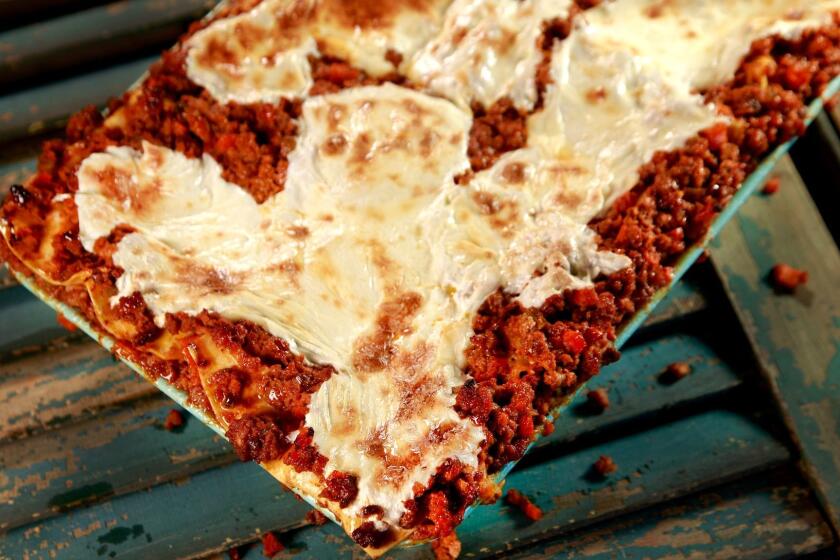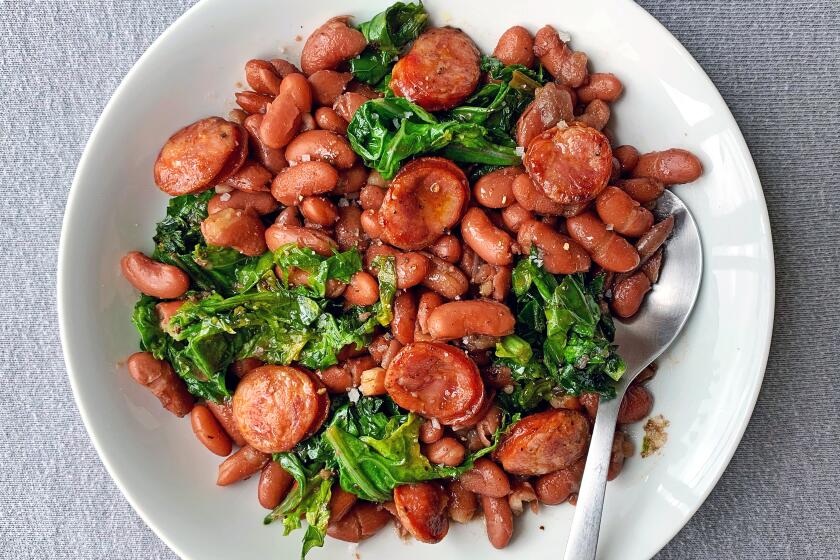How to cook through that restaurant’s produce box you bought

- Share via
As trips to the grocery store are becoming more fraught, many restaurants in Los Angeles have transitioned into de facto grocery stores, selling prepared foods and CSA-style produce boxes. Pandemic or otherwise, the response to a CSA (community supported agriculture) box — i.e., a crate of wonderfully fresh things from a farmer that you didn’t personally select — is usually, “What am I going to do with all this?!”
First: Stay calm. You’ve got this. Here’s my approach to tackling such sudden abundance:
Step 1: Sprawl it
Set the box on your kitchen floor then pick out each ingredient and lay it on your cleaned work surface (my colleague Genevieve Ko goes into detail about how to prep your kitchen for cooking under quarantine).
Next, group like with like: all hearty greens with stalks, like kale and Swiss chard, go in one pile; softer greens like spinach or bok choy go in another. Assorted bulbous things like onions, fennel, potatoes, cucumbers, carrots, cabbage and any citrus go in another area — you get the gist.
Now you know what you’ve got to work with. If you look at your pile and don’t recognize something, download the Picture This app. Typically used to identify plants in nature, it will tell you what the mystery specimen is simply by taking a picture of its leaves. Make a list of all the things your box has given you.
Step 2: Clean it
Certain kinds of produce need a simple rinse and dry with a paper towel, like fennel, cucumbers, onions, cabbage and celery stalks. Pile them in a colander and turn on the faucet, picking each up and giving it a scrub with your hands before shaking off the excess water and placing them on clean kitchen towels to dry. For carrots and any particularly dirty spuds, give them a scrub with the rough side of your sponge (if your carrots or fennel came with their leafy tops, cut those off first and set them in your herbs or soft greens pile). For any leafy greens, though, you’re going to want to wash them in lots of water, spin them dry and get them into bags to store in your fridge. Here’s how to do it:
Clean and disinfect your sink basin. Stop it up with its plug or a small bowl or cup that just fits inside it and fill it almost to the brim with cold water. Starting with your herbs or soft greens and working with one type at a time, swish them around in the water then let them sit for about 2 minutes to allow any dirt on them to fall to the bottom of the sink. Using your fingers like those claws in the arcade games (remember the scene in “Toy Story”?), gently lift out your greens, shake off any excess water, then transfer them to a salad spinner to further dry them. If you don’t have a salad spinner, shake them dry as much as you can, then lay them on paper towels. After they’re dry, spread them out in an even layer on a strip of paper towels or a large kitchen towel and roll them up, jelly roll-style, in the towel. Place the rolls in a large zip-top plastic bag and label each with the name and date. (If you don’t have plastic bags or don’t want to use them, you can wrap the bundles loosely in plastic wrap or store them as they are in the fridge, but just know that they will dry out quicker that way.)
Repeat this whole process with your herbs and soft greens before moving on to the hearty greens. For those, you’ll want to strip the leaves off their stalks and discard them (unless you have Swiss chard; their stems are tender enough to be sautéed). Tear the dark green leaves into hand-size pieces and then give them a swish in the water too, being a little more vigorous and massaging them in the water to make sure you rub off any dirt; it clings to them more stubbornly than to softer greens. Drain and dry them just like the other greens and label them in their bags. Yes, the whole process takes a while, but it sets you up for easy prep later.
Contrary to viral videos, the FDA says to not use dish soap to wash fruits and vegetables because soap is not meant for human consumption and could make you sick.
Step 3: Store it right
Once you have everything labeled and packed neatly in bags (or towel rolls), figure out how you’re going to store everything. Onions, potatoes and citrus can all stay out on the counter. For just about everything else, it’s going in the refrigerator, so open your fridge, take some time to clean out all the crap you haven’t used in over a week, and clean and organize your shelves. Once that’s done, put everything in its right place. If you have a produce drawer, use it. Hearty greens like kale and mustard greens can all go in one drawer with any bulby things like fennel, cucumbers, radishes, carrots and celery. All the soft greens and herbs can go in another drawer, if you have it, or on a shelf together.
Step 4: Sit down and make a plan
Get that list you made earlier and, in a separate column, make a list of dishes that you might want to make with the ingredients. Look online for inspiration, but also think about multipurpose ways to cook — for example, if you roast the sweet potatoes or beets and keep them chilled in your fridge, you can toss them in a salad or a grain bowl or just have them as a side with dinner throughout the week. Other things, like radishes, can simply be eaten raw, so you’ll want to eat those first since you won’t be cooking them and, thus, preserving them further.
Draw lines to connect the dots, then start a clean list of what you came up with. Take the time to make some things you know and love but also pick dishes that you’ve never made before because either you didn’t have the time or were missing that particular surprise ingredient you just identified. Never cooked cabbage before? Sure, you could shred it for coleslaw, but how about roasting it or making kimchi? You can, of course, skip making this type of general game plan to organize your time and cooking, but that’s setting yourself up for failure. Take the time and put pen to paper.
I stocked my fridge and freezer with plenty of ready-to-heat meals to share with friends so they could take a night off from dinner for a change too.
Once you have a plan set before you, this is when the fun begins. I recently purchased a produce box from All Time, my neighborhood restaurant. I chronicled the experience on The Times Food Instagram page (click on our stories to watch, or click the highlights button labeled “Produce Box”). Here’s how I tackled it:
After bringing the box home and getting everything washed and sorted, I took stock. There were a couple of onions, both purple and yellow; a bunch of carrots with their tops; a bunch of celery; three large Japanese sweet potatoes; three bulbs of fennel with their stalks and fronds; two bunches of young mustard greens; four Persian cucumbers; two watermelon radishes; a bunch of scarlet-stemmed Swiss chard; and about six heads of bok choy. Also included were two lemons and a large mandarin, a lagniappe of citrus in an otherwise greens-heavy crate.
With the yellow onions, carrots and celery, I knew I had the base of any kind of soup, stew or braised dish, but I wrote “chicken soup” by them since I knew I had chicken in the fridge to use. For the sweet potatoes and fennel, I knew I’d simply cut each into wedges and roast them, since I like to keep those types of things in my fridge for adding to salads, grain bowls or with my morning pan of scrambled eggs. Similarly with the cucumbers and radishes, I eat those like chips, so I knew I’d eat them raw or sliced up in salads.
I had just run out of some pickled red onions, so I took the opportunity to make more from one of them in the box. I thinly sliced it, crammed it in a glass jar that just fit it, then poured over an equal mix of red wine vinegar and water, sweetened with sugar and seasoned with a hefty pinch of salt and bay leaves.
Quick Pickled Onions
Similarly, I needed a fresh stock of pesto, so I took advantage of having all those carrot tops to make more. I tossed them in a food processor with the zest and juice of one of the lemons, a big handful of almonds, an equal amount of Parmesan cheese, a couple of cloves of garlic and a slow, steady pour of olive oil. I rained down salt and pepper, then blitzed the whole thing until it was even and spreadable. Scraped into a jar, it will last me for a couple of weeks, dolloped on eggs or spread on toast for lunchtime sandwiches. Of course, a hearty spoonful would be great on any plain pasta or gnocchi for dinner one night when I just can’t gather the energy to do much more.
Easy Carrot Top Pesto
I had a handful of leftover carrot tops and lots of fennel fronds, which, looking like and tasting so similar to dill, inspired me to make kuku sabzi, a Persian frittata of sorts, teeming with chopped herbs. I found some halved cherry tomatoes that were calcifying in the back of my fridge so I halved them and cooked them in a skillet with lots of salt and pepper until they were soft and tasted like tomatoes again. I stirred in all the finely chopped herbs mixed with eggs, then topped everything off with some grated Asiago cheese, another unearthed treasure from the deep recesses of my fridge. After it baked, I let it cool completely, then cut it into wedges and packed each in a bag. Into the fridge they went to be rewarmed and eaten for breakfast throughout the week or cold in sandwiches for lunch.
I had lofty plans of slicing the bok choy and adding it to a cold sesame noodle salad for lunch but ended up, along with half the Swiss chard leaves, simply sautéeing them in olive oil with garlic, chile flakes and salt and pepper to add a healthy balance to whatever meaty, carby dish I was eating to comfort myself.
And just as my plans for the bok choy changed, so did the ones for that chicken soup. I unearthed a pound of fancy ground beef from my freezer (noticing a pattern here?) and instead decided to turn it, and those onions, carrots and celery, into a down-and-dirty ragu sauce. I decided to use up the remaining leaves of Swiss chard and their stems here too. I sautéed the leaves first, then set them aside to cool so I could chop them while the sauce cooked and stir them in at the end. I sliced up the stems and cooked them down with the mirepoix vegetables until soft and yielding. In went some tomato paste, followed by several glugs of red wine and then the beef. Once browned, I tossed in a couple cans of tomatoes (one of the whole, peeled variety, the other crushed — use what you have!) and some water and stewed the sauce for 2½ hours. I stirred in the greens and packed it into containers. One went into the fridge for the next night’s pasta dinner while the other two went into the freezer for future dinners, one of which will definitely be lasagna.
Anthony Bourdain's Lasagna Bolognese
The last ingredient to use up was the mustard greens. Being a Southern boy, I had first thought of braising them with smoked pork necks, like my grandmother used to do when I was a child, but the best greens for those are the hearty, older specimens that need that kind of cooking to be tender and delicious. Instead, I took inspiration from the bag of dried red kidney beans in my pantry that I had recently brought back from New Orleans along with a pack of andouille sausage in the freezer from the same trip and decided to make Cajun-style red beans that I’d then mix with the mustard greens.
I first rendered out some of the sausage’s spicy, brick-red fat in olive oil until the andouille was golden brown. I sautéed the mustard greens in half of the fragrant fat, then set it aside, like the Swiss chard in the Bolognese before, to be stirred in at the end, to preserve its al dente crunch. (In general, if you get a mystery green and don’t know what to do with it, sauté it in oil of some sort until just wilted but still slightly crunchy; season with salt and pepper and you’re good to go.) To the rest of the fat, I sautéed a small onion, a couple of cloves of garlic and a bay leaf until soft. In went my red beans (these were so fresh they didn’t need to be soaked) and water, then everything bubbled away gently for about an hour or so until the beans were tender and imbued with the sausage’s paprika-scented fat. I stirred in the cooked sausage and mustard greens, then spooned some immediately over a scoop of freshly cooked white rice.
Red Beans and Greens
At the end of the week of cooking through the box, I was delighted with what I had stocked in my fridge and freezer. Plenty of ready-to-heat meals for future dinners, some condiments to use to brighten the quick meals I’ll throw together on the daily, and some containers to share with friends so they could take a night off from dinner for a change too, which, right now, is the best gift you can give anyone.
More to Read
Eat your way across L.A.
Get our weekly Tasting Notes newsletter for reviews, news and more.
You may occasionally receive promotional content from the Los Angeles Times.
